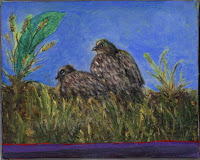
Charles Frank "Devo" Ragsdale died of cancer on February 12, 2010. He was an aspiring artist and intellectual whose life can best be summed up in Henry David Thoreau's quotation
"If a man does not keep pace with his companions, perhaps it is because he hears a different drummer. Let him step to the music which he hears, however measured or far away." Devo was a teacher who taught in New England, California and Texas; an avowed Zionist who had an excellent knowledge of Middle Eastern history and current events; and a football fan with an encyclopedic knowledge of college and pro football statistics. After retirement he became a reclusive artist who was convinced that his next painting would bring him fame.
Devo was one of my best friends for over 50 years. I am the proud owner of three of his more realistic paintings. The painting of birds above was done for me when my wife died in November 2006. His paintings tended toward Impressionism and Cubism to such an extent that they were incomprehensible to most people. Over the years we had many good natured arguments about his style of painting. I kept telling him he could be a successful commercial artist if he would switch his painting style to Realism. And he would tell me I did not recognize good art when I saw it and that he refused to prostitute himself to the commercial art world just to be successful.










